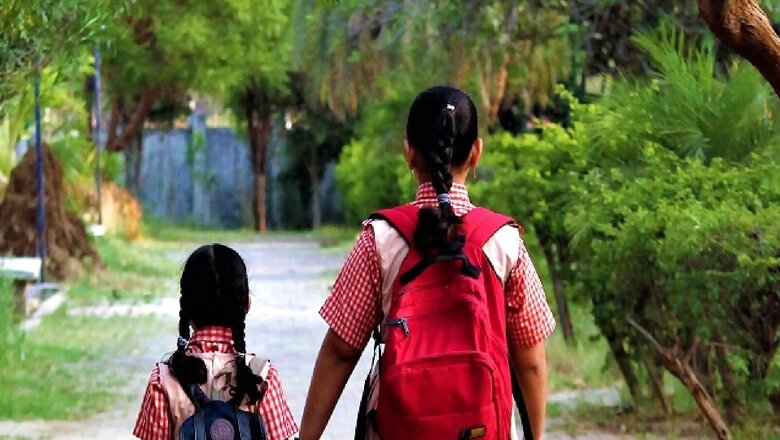
views
Lata Hembram (fictional name) lives in an adivasi village 20 kilometres away from Jhargram in West Bengal. A 30-year-old adivasi woman, she is a mother to two children who are seven and five years old. Lata does not know how to read or write. She feels the pain of not having learnt to read. She works as an attendant at a local cycle stand, a place where men and women keep their bicycles for the day before boarding a bus for Jhargram, Kharagpur or an even faraway city to make a living and pick up their bicycles at the end of their workday. When the cycle stand owner pays her Rs 70 for a day’s work, the different colours of banknotes tell her the exact amount that she has earned. She knows the colours but she does not know the letters.
Olivia Bose (fictional name) is a 35-year-old university graduate, she did a Masters in Journalism and Mass Communication from Rabindra Bharati University in Kolkata. She works on the editorial desk of a popular Bengali television news channel. After 10 years of working with the company, she has made enough savings and this year in 2021 she has bought a two-bedroom apartment in the southern fringes of the city. She took a home loan of Rs 15 lakh and has put in the rest from her savings to buy this flat for Rs 20 lakh. She has made a smart arrangement such that the EMI for the loan will be deducted each month from her salary, directly from her bank account. Olivia grew up in Jalpaiguri in northern West Bengal. Now that she has moved into her new flat, she hopes her parents will come to Kolkata and stay with her.
Lata and Olivia are both Indians, both have Aadhaar cards, and they are also legitimate voters in the elections to India’s Parliament, to the state Assembly and to the local municipality/panchayat. They live barely 200 kilometres away and yet their lives are so far apart. Olivia rides the wave of an India where digital economy and many things digital are changing our lives every single day. Lata, on the other hand, far from being versed in digital literacy, is not even literate, not in her native Santhali, nor in Bengali, Hindi or any other Indian language. Olivia is part of a young India on the move, aspirational, ambitious and confident; Lata is part of another young India who stare blankly into empty space with an expectation of no more than Rs 70 a day as cycle station attendant in one rural corner of India.
Economists and policy makers, occasionally politicians too, talk of India’s demographic dividend. India has one of the largest percentages of young people as a proportion of the nation’s population. The argument goes that a young population and relatively low cost of labour will help propel India to faster economic growth. However, it has been often pointed out that unless this young population gets educated and acquires requisite skills that enable them to participate in modern economic sectors, the huge numbers will be of little use.
Layers of Disparity
In 1951, four years after Independence, India’s literacy was 9 per cent, today 74 years later it is 77 per cent, roughly seven times from what it was 70 years ago. It may look a giant stride but if we compare this with China and South-east Asian nations, our achievements in literacy and elementary education look insignificant. And even within this 77 per cent, there are layers of disparity. Female literacy is at 70 per cent while male literacy is at 84 per cent. If we look at upper caste and urban Indians—a large proportion of readers of this article may belong to one of those categories—the literacy rate will be close to 100 per cent. If we look at tribals in central India living in rural and/or forest communities, the literacy rate could be around 50 per cent.
It is the socially marginalised that are educationally deprived. There are probably 50 schools within five square kilometres of downtown Kolkata, Delhi or Mumbai, but there may be at best one school in 50 kilometre radius in areas of Chhattisgarh or other parts of central India. India’s rich and powerful, among them educated middle classes like me and you, care little for India’s educational have-nots.
Focus on Universal Literacy
The governments at the Centre or in the states have launched schemes that have had mixed results. Sarva shiksha abhiyan during the Congress regimes or Beti bachao beti padhao campaign of the present NDA government are important milestones but we are still far from achieving 100 per cent literacy and a robust elementary education. There are NGOs, there are voluntary organisations, there are dedicated volunteer activists with missionary zeal who are foot soldiers of literacy—some organisations have been around since 1920s, 30s and 40s—but still the darkness lingers.
Altruism alone cannot lift India out of illiteracy. There needs to be a deeper appreciation of why the last woman becoming literate and educated is important for those of us who participate in and enjoy the benefits of a modern economy. For instance, if you get into a taxi in Mumbai, Chennai or any other city, and if the taxi does not have a smart phone with Google Maps, and if you try showing a map to the taxi driver, often they may not be able to read the map. In our neighbouring Thailand though, all taxi drivers in Bangkok know to read a map, they read it in Thai, their mother tongue, and the natural language of the city. It is just one of million examples where the blue collar worker’s education matters to the white collar professional.
A deep appreciation among the powerful educated ‘great Indian middle class’ of the need for the working classes to become literate alone can change the situation. Indian industry bemoans the lack of quality plumbers or quality carpenters. All these depend on universal literacy, universally accessible quality elementary education, in mother tongues and natural languages of our people.
The day Olivia rides a Rapido motor bike where Lata, the driver, is able to read the map, that day India would transform from a poor illiterate nation to a wealthy rich society, where each of our fellow citizens gets a fair share of access to education and is able to participate in the ever-expanding digital revolution.
The author is Professor of Communications at Anant National University, Ahmedabad. He is editor of Eastern Review monthly magazine published out of Kolkata, India. The views expressed in this article are those of the author and do not represent the stand of this publication.
Read all the Latest News, Breaking News and Assembly Elections Live Updates here.














Comments
0 comment